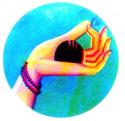 | Jangama | Guru |  |
IshtaLinga ( Linga ) |

The Linga is given to the body at the time of birth, as is the custom. The Linga is always on the body of a person till his death. The person should never lose his Linga , Ishtalinga is always carried on some part of the body, usually the neck, while work or other situations on the left arm, and is placed in the left hand of the deceased when the body is committed to the grave. Men and women, old and young, rich and poor, all alike wear this symbol of their faith and its loss is regarded as spiritual death, though in practice the loser can, after a few ceremonies, are invested with a new one.
The daily worship of the Linga , before the Deeksha ceremony of a person is performed, may be informal but necessary for the person, so that he may be imbibed with deep reverence for the God and impressed with the significance of spiritual discipline. Though informal, it has its own significance. It makes the wearer and worshipper conscious of his duty to God on account of his uncertain position in worldly life. It makes him aware of the necessity of religious life and spiritual discipline in the way of Mukti. The real worship of Linga as the religious exercise begins after the Deeksha ceremony performed by the Guru , who initiates a person into the secrets of religion and explains how to do puja how to worship the Linga .
The Linga is given to the person at the time of birth and worn on the body all the time until the death. The person never should lose the Linga, because losing Linga is losing his/her life. The real worship of Linga begins after the Diksha ceremony performed by the Guru, who initiates the person into the religious rights. However, the daily worship of Linga before the Diksha may be informal but necessary that makes the wearer and worshipper conscious of his duty to the Supreme Godhead. It makes him/her cognizant of the essentiality of religious life and spiritual discipline on the way towards Mukti.
The worship of Istalinga is not worship of image because image is merely a substitute for a particular deity. The Istalinga is considered not an image of God but God himself. Devote is also the modification of God and is called Anga. Thus the Anga and Linga being duality of the God, the worshipper and worshipped are face to face with each other during the worship. The Anga views Linga as his/her associate, friend and protector by living with and in him making him part of himself. Anga is the microcosm of the macrocosmic Linga. Anga by its virtue is trapped in the physical body and to be free form it, Anga must worship Linga, the superior modification but identical with Dhanalinga, the macrocosmic soul. The Anga, the worshipper fixes his/her attention on the Linga, the macrocosmic soul, to become Samarasa (one) with him ultimately.
In the early stage, the Linga is the Sarupa (having the same form) of the devotee. He is, therefore, his intimate friend and everlasting companion. In this stage, the devotee is in Savikalpakasamadhi. Through the steady worship of Linga, devotee gradually acquires the higher ideal of Samarasya in the advanced stage. In this stage the devotee is in Nirvakalpaksamadhi.
The Linga is the representation of the devotee in meditative posture. Thus Linga and Anga are it and reverse of itself of the same and the same thing. Anga, being microcosmic with all the earthly limitations confined to the physical body realizes that the Linga is macrocosmic free from limitations of earthly desires. If Anga desires to attain Linga stage then it must develop in itself a power of Bhakti, the modification of God's Shakti (power). Without Bhakti, sincere devotion and attachment to the Supreme, nothing is possible.
The real Linga in the body exists in various forms in six centers of the nerve, which, according to Rajayoga, are known as Adharas of Shakti. The worship of those Lingas to transform the human power into a vast spiritual and all-reaching spiritual power constitutes what is known as "the real worship." This is most difficult and not an easy task in the beginning. However, it is possible by realizing that He is in himself/herself and with a constant devotion to the God. This constant devotion is perfected through Istalinga. Hence, the Anga must be disciplined to think that Highest in him/her and in Istalinga, and start worship of Istalinga realizing that he/she is Shiva and Shiva is Jiva(soul).
Lingangayoga: The yoga given by Guru Basavanna that enables an individual to achieve the union with the divine while living in this mortal realm. The word 'yoga' means union, typically used to denote the union of an individual soul with divine. There are many forms of yoga that lead to the union of individual with the divine. Lingangayoga is the novel form of yoga given by Guru Basavanna. This is done using the Ishtalinga. It is also known as "Tratakyoga." Here, divine unites with the individual enabling the transformation of an individual to Sharana
 | Jangama | Guru |  |